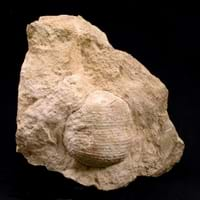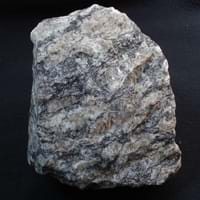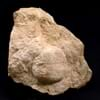Definition
Limestone is a sedimentary rock composed mostly of calcite and aragonite, which are different crystal forms of calcium carbonate
Gneiss is a common and widely distributed type of rock formed by high-grade regional metamorphic processes from pre-existing formations that were originally either igneous or sedimentary rocks
Origin
New Zealand
Unknown
Discoverer
Belsazar Hacquet
Unknown
Etymology
From lime and stone in late 14th Century
From the Middle High German verb gneist (to spark; so called because the rock glitters)
Class
Sedimentary Rocks
Metamorphic Rocks
Sub-Class
Durable Rock, Medium Hardness Rock
Durable Rock, Hard Rock
Group
Not Applicable
Not Applicable
Other Categories
Fine Grained Rock, Opaque Rock
Coarse Grained Rock, Medium Grained Rock, Opaque Rock
Texture
Clastic or Non-Clastic
Banded, Foliated, Platy
Color
Beige, Black, Blue, Brown, Cream, Gold, Green, Grey, Light Green, Light Grey, Linen, Pink, Red, Rust, Silver, White, Yellow
Black, Brown, Pink, Red, White
Durability
Durable
Durable
Scratch Resistant
Yes
Yes
Appearance
Rough and Banded
Foliated
Interior Uses
Decorative Aggregates, Interior Decoration
Countertops, Decorative Aggregates, Flooring, Interior Decoration
Exterior Uses
As Building Stone, As Facing Stone, Garden Decoration, Office Buildings
As Building Stone, As Facing Stone, Garden Decoration, Paving Stone
Other Architectural Uses
Curbing
Curbing
Construction Industry
Cement Manufacture, Cobblestones, for Road Aggregate, Production of Glass and Ceramics, Raw material for the manufacture of mortar, Roadstone, Source of calcium
As Dimension Stone
Medical Industry
In Chemical and Pharmaceutical Industry, Medicines and Cosmetics
Not Yet Used
Antiquity Uses
Artifacts, Monuments, Sculpture, Small Figurines
Artifacts
Commercial Uses
Animal feed filler, As a Feed Additive for Livestock, Paper Industry, Raw material for manufacture of quicklime, slaked lime, Soil Conditioner, Used in aquariums, Whiting material in toothpaste, paint and paper
Cemetery Markers, Jewelry, Tombstones, Used in aquariums
Types
Chalk, Coquina, Fossiliferous Limestone, Lithographic Limestone, Oolitic Limestone, Travertine, Tufa
Augen Gneiss, Henderson Gneiss, Lewisian Gneiss, Archean and Proterozoic Gneiss.
Features
Host Rock for Lead, Stalactites and stalagmites are formed from this rock, Zinc and Copper Deposits
Generally rough to touch, Is one of the oldest rock
Archaeological Significance
Famous Monuments
Acropolis of Athens in Greece, Agia Sophia in Istanbul, Turkey, Al Aqsa Mosque in Jerusalem, Angkor Wat in Cambodia, Big Ben in London, Charminar in Hyderabad, India, Chhatrapati Shivaji Terminus in Maharashtra, India, Chichen Itza in Mexico, Empire State Building in New York, Khajuraho Temples, India, Kremlin in Moscow, Louvre in Paris, France, Neuschwanstein in Bavaria, Potala Palace in Lahasa, Tibet, Wailing Wall in Jerusalem
Konark Sun Temple in India, Washington Monument, US
Sculpture
Used
Not Yet Used
Famous Sculptures
Ajanta Caves in Maharashtra, India, Elephanta Caves in Maharashtra, India
Not Applicable
Pictographs
Used
Not Used
Petroglyphs
Used
Not Used
Figurines
Used
Not Yet Used
Formation
Limestone is a sedimentary rock which is mainly made up of calcium carbonate.
Gneiss is a high grade metamorphic rock i.e. it has been subjected to higher temperatures and pressures than schist. It is formed by the metamorphosis of Gneiss forms from volcanic rock, shale or granitie.
Mineral Content
Calcite, Chert, Clay, Dolomite, Quartz, Sand, Silt
Biotite, Chlorite, Feldspar, Garnet, Graphite, Hornblade, Micas, Muscovite or Illite, Quartz, Quartzite, Silica, Zircon
Compound Content
Aluminium Oxide, NaCl, CaO, Iron(III) Oxide, FeO, MgO
Aluminium Oxide, NaCl, CaO, Iron(III) Oxide, FeO, Potassium Oxide, Magnesium Carbonate, MgO, MnO, Phosphorus Pentoxide, Silicon Dioxide, Titanium Dioxide
Types of Metamorphism
Not Applicable
Impact Metamorphism
Types of Weathering
Biological Weathering, Chemical Weathering, Mechanical Weathering
Biological Weathering, Mechanical Weathering
Types of Erosion
Chemical Erosion, Coastal Erosion
Chemical Erosion, Coastal Erosion, Sea Erosion
Grain Size
Fine Grained
Medium to Coarse Grained
Fracture
Splintery
Irregular
Porosity
Less Porous
Very Less Porous
Luster
Dull to Pearly
Dull
Cleavage
Non-Existent
Poor
Specific Gravity
2.3-2.7
2.5-2.7
Transparency
Opaque
Translucent to Opaque
Density
2.3-2.7 g/cm3
2.6-2.9 g/cm3
Specific Heat Capacity
Not Available
Resistance
Pressure Resistant
Heat Resistant, Pressure Resistant, Scratch Resistant, Wear Resistant
Deposits in Eastern Continents
Asia
Brunei, India, Indonesia, Malaysia, Singapore, Thailand, Vietnam
China, India, Iran, Iraq, Kazakhstan, Kyrgyzstan, Mongolia, Russia
Africa
Cameroon, Chad, Ghana, Kenya, Malawi, Sudan, Tanzania, Togo, Zambia, Zimbabwe
Cameroon, Ethiopia, Ghana, Kenya, Madagascar, Morocco, Mozambique, Namibia, Nigeria, Tanzania, Togo
Europe
United Kingdom
Albania, Austria, Bosnia and Herzegovina, Finland, France, Georgia, Germany, Hungary, Italy, Kosovo, Monaco, Norway, Poland, Romania, Serbia, Slovakia, Slovenia, Switzerland, Ukraine, United Kingdom
Others
Not Yet Found
Not Yet Found
Deposits in Western Continents
North America
USA
Canada, Costa Rica, Cuba, Mexico, Panama, USA
South America
Colombia
Argentina, Bolivia, Brazil, Chile, Colombia, Ecuador, Peru, Venezuela
Deposits in Oceania Continent
Australia
Adelaide, New Zealand, Queensland, Tonga, Victoria, Yorke Peninsula
New South Wales, New Zealand, Queensland, Victoria
Limestone vs Gneiss Characteristics
Though some rocks look identical, they have certain characteristics which distinguish them from others. Characteristics of rocks include texture, appearance, color, fracture, streak, hardness etc. Limestone vs Gneiss characteristics assist us to distinguish and recognize rocks. Also you can check about Properties of Limestone and Properties of Gneiss. Learn more about Limestone vs Gneiss in the next section. The interior uses of Limestone include Decorative aggregates and Interior decoration whereas the interior uses of Gneiss include Countertops, Decorative aggregates, Flooring and Interior decoration. Due to some exceptional properties of Limestone and Gneiss, they have various applications in construction industry. The uses of Limestone in construction industry include Cement manufacture, Cobblestones, For road aggregate, Production of glass and ceramics, Raw material for the manufacture of mortar, Roadstone, Source of calcium and that of Gneiss include As dimension stone.
More about Limestone and Gneiss
Here you can know more about Limestone and Gneiss. The life cycle of a rock consists of formation of rock, composition of rock and transformation of rock. The composition of Limestone and Gneiss consists of mineral content and compound content. The mineral content of Limestone includes Calcite, Chert, Clay, Dolomite, Quartz, Sand, Silt and mineral content of Gneiss includes Biotite, Chlorite, Feldspar, Garnet, Graphite, Hornblade, Micas, Muscovite or Illite, Quartz, Quartzite, Silica, Zircon. You can also check out the list of all Sedimentary Rocks. When we have to compare Limestone vs Gneiss, the texture, color and appearance plays an important role in determining the type of rock. Limestone is available in beige, black, blue, brown, cream, gold, green, grey, light green, light grey, linen, pink, red, rust, silver, white, yellow colors whereas, Gneiss is available in black, brown, pink, red, white colors. Appearance of Limestone is Rough and Banded and that of Gneiss is Foliated. Properties of rock is another aspect for Limestone vs Gneiss. The hardness of Limestone is 3-4 and that of Gneiss is 7. The types of Limestone are Chalk, Coquina, Fossiliferous Limestone, Lithographic Limestone, Oolitic Limestone, Travertine, Tufa whereas types of Gneiss are Augen Gneiss, Henderson Gneiss, Lewisian Gneiss, Archean and Proterozoic Gneiss.. Streak of rock is the color of powder produced when it is dragged across an unweathered surface. The streak of Limestone and Gneiss is white. The specific heat capacity of Limestone is 0.91 kJ/Kg K and that of Gneiss is Not Available. Depending on the properties like hardness, toughness, specific heat capacity, porosity etc., rocks are resistant to heat, wear, impact, etc.Limestone is pressure resistant whereas Gneiss is heat resistant, pressure resistant, scratch resistant, wear resistant.





